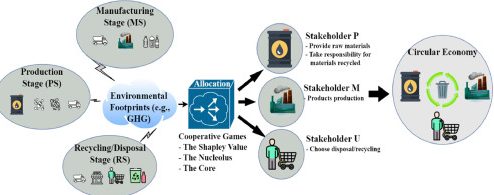Life Cycle Assessment is the primary approach to quantify the environmental impacts of plastics. However, it encounters challenges in allocating the impacts of respective stages to stakeholders, especially for systems involving multi-cycles and end-of-life stages. This study proposes a framework integrating Cooperative Game Theory to assess and allocate the greenhouse gas footprint among stakeholders. The applied concepts are the Shapley Value, Nucleolus and Core. The applicability is demonstrated by a case study of polyethylene terephthalate (PET) with four recycling and landfill scenarios. The Shapley Value, which highlights fair allocation, suggests ∼ 792–1164 kg of unburdening CO2eq/t PET (∼ 47 % net recycling credits) assigned to material producers, 844.5–1216.5 kgCO2eq/t PET to product manufacturers, and the remaining ∼ 2–3 % to users. The Nucleolus stresses satisfactory results in 1531.5–2275.5 kgCO2eq/t PET to material producers, constituting ∼ 90 % of the total credits. The allocation does not change the total footprints; however, it is essential for the stakeholders’ cooperation in environmental initiatives.



